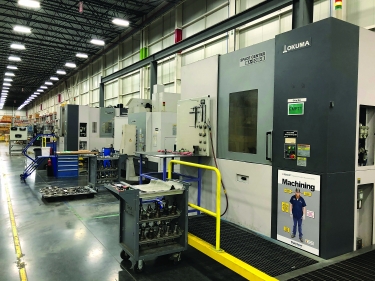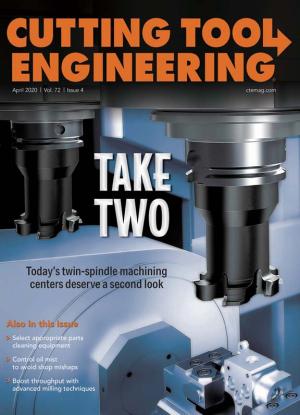I had the privilege of learning the machining craft at my family’s machine shop. It was a true mom and pop shop where we made anything that would pay the bills. As orders grew larger and parts became more complex, it was clear that our future would depend on successfully integrating CNC equipment into our shop. In 1995, we purchased our first machining center: a small one without any options.
Buying it launched our shop to the next level. Five weeks after receiving the machine, we ordered another just like it. I programmed them with a pencil, paper and a calculator, typed codes into the controls and stored all programs in the machine tool controls. We used edge finders and indicators to set parts and measured tool lengths by touching parts with each tool. Compared with today’s technology, our methods were crude.
Machining centers and techniques have advanced at a fast pace since I started programming and operating CNC machines. A few significant improvements have transformed the machines into what we use today, enhancing shop and machinist efficiency.
Need for Speed
Our first CNC machine was capable of only a 7,500-rpm spindle speed. Although machines were available with higher-speed spindles, those machines were expensive and rarely found at small shops.

Mitsubishi Hitachi Power Systems Americas has several machining centers (right) with features like high-torque
spindles and through-spindle coolant. Image courtesy of C. Tate
When we bought our original machines, we would have needed to use some type of ancillary device, such as an air spindle or a geared spindle speeder, to achieve higher spindle speeds. In addition to being costly, spindle speeders were often unreliable and underpowered. Today, it is common for machining centers to have 20,000-rpm spindles.
Spindle speed may sound insignificant, but it has a direct impact on the programmed feed rate of a machine tool. High feed rates usually mean high removal rates and reduced cycle times, making a shop more efficient.
Every programmer should know that rpm multiplied by feed per tooth equals inches per minute. So as spindle speeds increased, more dynamic machine tools were needed.
Our initial CNC machine was not high end but had comparable specifications to many other machining centers on the market. In rapid traverse mode, the machine would travel 10.16 m/min. (400 ipm). In a feed move, the machine could go 6.35 m/min. (250 ipm). Machines today are capable of rapid traverse and cutting feed rates in excess of 60.96 m/min. (2,400 ipm) — six times faster than our machine.
As machining centers have become more dynamic, the use of advanced milling techniques, commonly called high-speed machining, has gained popularity. HSM offers many benefits like reduced cutting forces, extended tool life and large depth-to-diameter ratios, all of which increase milling efficiency. HSM toolpaths are based on maintaining uniform chip thickness across a profile, which requires substantial computing power. Therefore, creating HSM paths without software would be impossible.
Growth of CAM
Few shops 25 years ago used CAM software as we do today. Small shops relied on conversational controls or — like we did at my shop — used brute force by writing G code on paper and then typing that into a control. Even large companies at the time depended on unwieldy systems, such as Automatically Programmed Tool, a cumbersome Fortran-based language that required thousands of hours to master.
CAM software with a graphical user interface transformed programming into an activity like a video game. Programming is so easy that almost anyone can create a simple toolpath after a few minutes of training. Without modern CAM software, HSM toolpaths would not be possible. And we would not have been able to fully capitalize on increased speeds without HSM.
Loading programs and other data into a CNC requires a communication system. At my family’s shop, I typically typed programs directly into a control, which was painfully inefficient. We tried to connect a machine to a computer to improve efficiency, but it never worked properly. We abandoned the project after determining that it was too complex for our skill set.
Machine tool controls now come designed to communicate, and connectivity is simple. Most have Cat5 connections and USB ports, and some have wireless connectivity. At least one builder already allows connection and data transfer with a smartphone. Connectivity, data collection and remote interaction with machines will dominate future control development.
Looking ahead, we will continue to see significant advances in communication, connectivity and data transfer. More importantly, I expect more machining and additive manufacturing processes to be combined into a hybrid platform in which a near net shape component is produced with an additive process and fine-tuned with a machining process. Making a part soon may be as simple as saying, “Hey, Siri, make a widget.”
Related Glossary Terms
- centers
centers
Cone-shaped pins that support a workpiece by one or two ends during machining. The centers fit into holes drilled in the workpiece ends. Centers that turn with the workpiece are called “live” centers; those that do not are called “dead” centers.
- computer numerical control ( CNC)
computer numerical control ( CNC)
Microprocessor-based controller dedicated to a machine tool that permits the creation or modification of parts. Programmed numerical control activates the machine’s servos and spindle drives and controls the various machining operations. See DNC, direct numerical control; NC, numerical control.
- computer-aided manufacturing ( CAM)
computer-aided manufacturing ( CAM)
Use of computers to control machining and manufacturing processes.
- coolant
coolant
Fluid that reduces temperature buildup at the tool/workpiece interface during machining. Normally takes the form of a liquid such as soluble or chemical mixtures (semisynthetic, synthetic) but can be pressurized air or other gas. Because of water’s ability to absorb great quantities of heat, it is widely used as a coolant and vehicle for various cutting compounds, with the water-to-compound ratio varying with the machining task. See cutting fluid; semisynthetic cutting fluid; soluble-oil cutting fluid; synthetic cutting fluid.
- feed
feed
Rate of change of position of the tool as a whole, relative to the workpiece while cutting.
- gang cutting ( milling)
gang cutting ( milling)
Machining with several cutters mounted on a single arbor, generally for simultaneous cutting.
- inches per minute ( ipm)
inches per minute ( ipm)
Value that refers to how far the workpiece or cutter advances linearly in 1 minute, defined as: ipm = ipt 5 number of effective teeth 5 rpm. Also known as the table feed or machine feed.
- milling
milling
Machining operation in which metal or other material is removed by applying power to a rotating cutter. In vertical milling, the cutting tool is mounted vertically on the spindle. In horizontal milling, the cutting tool is mounted horizontally, either directly on the spindle or on an arbor. Horizontal milling is further broken down into conventional milling, where the cutter rotates opposite the direction of feed, or “up” into the workpiece; and climb milling, where the cutter rotates in the direction of feed, or “down” into the workpiece. Milling operations include plane or surface milling, endmilling, facemilling, angle milling, form milling and profiling.
- rapid traverse
rapid traverse
Movement on a CNC mill or lathe that is from point to point at full speed but, usually, without linear interpolation.
- toolpath( cutter path)
toolpath( cutter path)
2-D or 3-D path generated by program code or a CAM system and followed by tool when machining a part.


